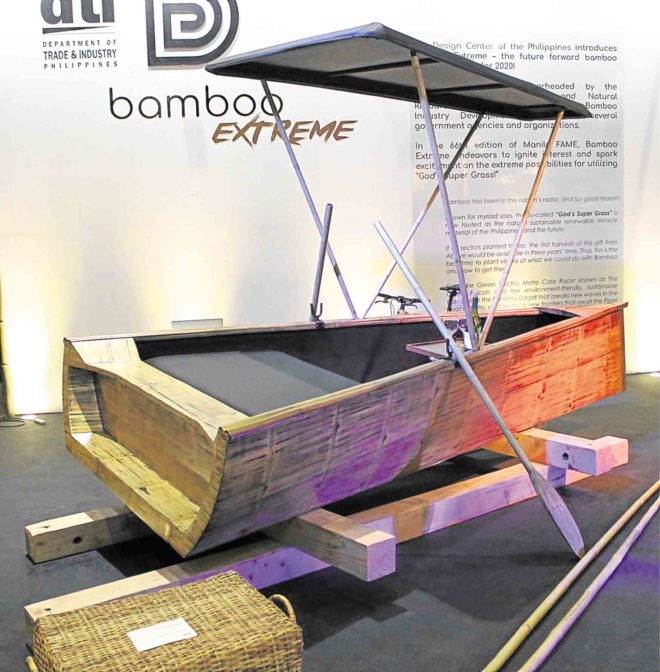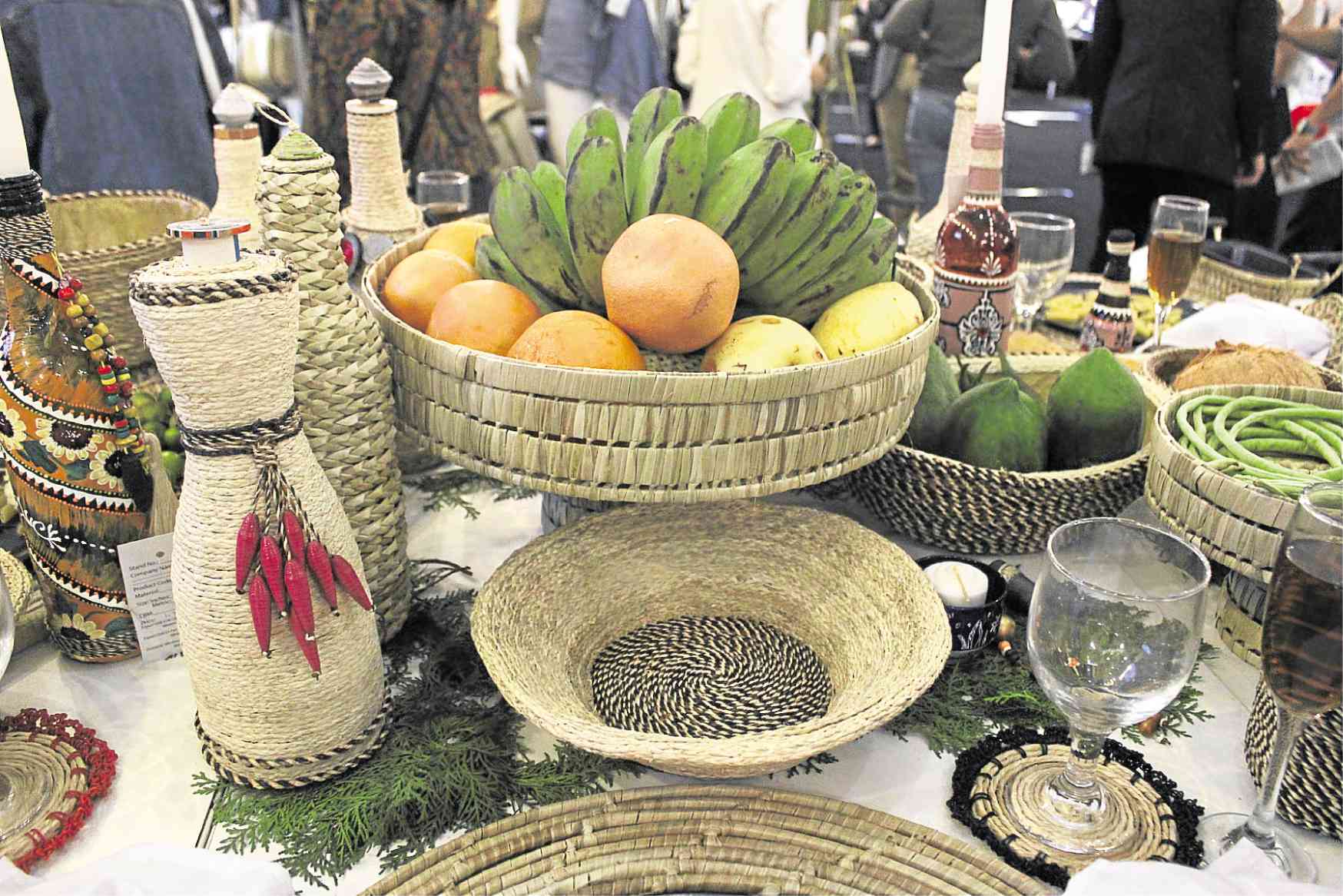
While some media focused on Whang Ud at Manila FAME (Furnishings and Apparel Manufacturers’ Exchange), the real story was the exhibition, which vibrated with fresh design and put a premium on sustainability.
Designers Tony Gonzales, Tes Pasola, Leo Sano and German consultant Detlef Klatt organized one of the main settings. The Design Commune was composed of manufacturers from all over the country, displayed in color-blocked sections.
The Blue and White was a nod to classic styles, such as blue-and-white Chinese ceramics, Delftware of the Dutch, and the indigo plant. The section had denim patchwork stools by Cebu Stonecraft, patterned tiles by Asia Ceramics and woven outdoor furniture with geometric designs that used PVC instead of traditional rattan strips.
The Green Tinted section carried not only the year’s fashion color, but also the concept of bringing the outdoors in. “Everybody wants to put a garden inside the house,” Gonzales said. A long table was made of strips of worm-eaten wood to show the beauty of imperfections. Paper cutouts of leaves served as placemats, and there were wire outdoor chairs with leaf patterns by Stanley Ruiz.
Tribal designs
Ethnic Nomad pushed bold colors and geometric patterns, highlighting tribal designs. Gonzales created a row of whimsical lamps made from patterned market baskets.
Naturals, Black and White focused on products using organic materials, such as Pasola’s buntal hats from Bulacan that were turned into lamps. Gonzales noted that products using natural materials were popular in European trade fairs.
The furniture and accessories were functional and saleable. Their basic looks, tried and tested on the market, were given a new spin.
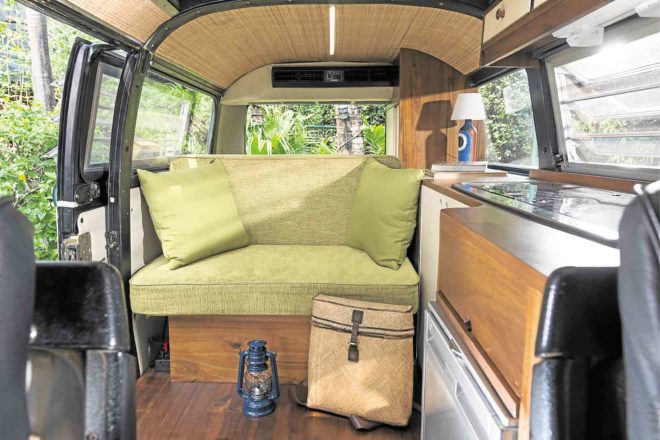
“Hindi suntok sa buwan (not guesswork),” Gonzales said. “I made sure that the designs have a lot of potential abroad. Buyers and consumers can easily connect with them.
Paris-based design consultant Nelson Sepulveda presented the New Generation Weaves, which highlighted the beauty of indigenous materials.
Traditional designs were given a different treatment. Rice granary gods, made of mango wood, were topped with trays to hold candles and nuts. Maze, a Pampanga factory known for elaborate designs, created a table with metal cutwork that mimicked patterned Machuca tiles.
Designs intrinsically linked with the environment were an important theme. The Design Center of the Philippines (DCP) tapped Ruiz and Milo Naval to organize functional objects using green materials.
Ruiz recycled plastic bottles for fabric conditioner, bleach and water into bases for lamps, topped by shades of corn husk twine, which is industrial waste.
He also showed how native materials such as abaca twine, corn husk paper from Cagayan de Oro Handmade Paper and bakong or spider lily plant from Cagayan region could be made into a transparent fabric.
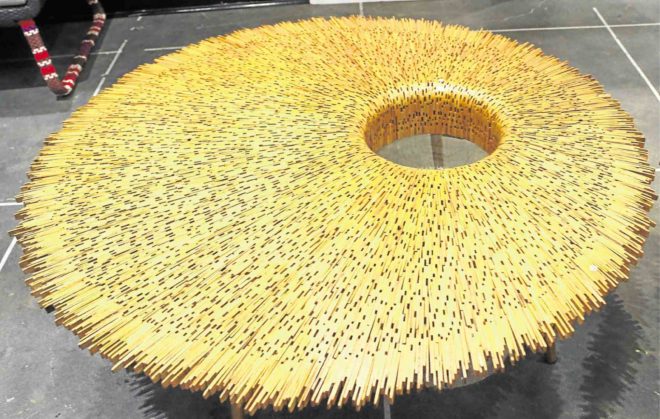
Naval was tasked to use the bamboo in innovative ways. “I want to show that bamboo can go beyond furniture, gifts and houseware,” he said.
The bamboo projects were a collaboration between the Department of Environment and Natural Resources, which planted the trees, the DCP for the vision, and Department of Science and Technology to develop the hardware.
Bamboo boats and bikes
Naval has been using bamboo as a surface finish for a boat and a padyak, the bike-driven rickshaw. Manufactured by his new company, Navaltect, the boat frame was built from marine plywood and coated with marine epoxy, while the padyak was made of metal frame and woven with bamboo slats.
The exhibit include the electric motorbike designed by Chris Lacson and Bryan Benitez, the McClelland’s Bambike. These bikes are a livelihood project of the Gawad Kalinga community in Victoria, Tarlac.
“The bamboo is a rapidly renewable resource. The Bambike combines sustainability with fair trade labor,” said McClelland. These bicycles are hand-wrapped with bamboo. The new collection introduces engineered bamboo. We passed the international bike standard for impact testing and durability. Bamboo is a natural shock absorber. Bicycles are the efficient and eco-friendly way to get around,”
Meanwhile, Illac Diaz of the Liter of Light Global Foundation collaborated with Philux furniture company’s Stephanie Gonzalez and Jessica Maxwell to make a Green Mobile Home.
Diaz invented sustainable lights from old plastic bottles with water and bleach that refract sunlight and illuminate the homes of the poor. He installed heat solar panels on the roof, LED lights and fire-safe sockets. Philux renovated the interiors of the VV Kombi with acacia wood and green upholstery.
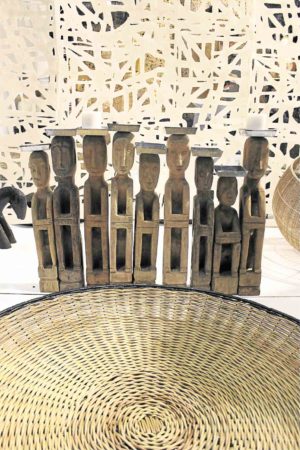
Meanwhile, PJ Arañador has been traveling around the country to train women on how to apply traditional craft technique to modern use. The Great Women Project is organized by the Philippine Commission on Women, in partnership with the Department of Trade and Industry Project Management Team, and is funded by the Canadian International Development Agency.
Arañador showed a modern application of ikat from Mindanao, by using the traditional tie-dye patterns in home linens. He taught women the Japanese knotting and tying technique to substitute for made-in-China hardware for bags.
“These microentrepreneurs were coached to make their products export quality,” he said.
Cebu in full force
For the first time, Cebuano manufacturers came in full force. Designer Debbie Palao explained that it was the first time that the local government supported Cebu’s furniture, accessories and fashion chambers. Their set-up, curated by Pasola, simulated a resort hotel. Different manufacturers presented low beds, tables, cabinets and trays in special finishes.
“We wanted to show that the Cebuano manufacturers can fit out an entire resort,” Palao said. Aside from making furniture under her eponymous label, she started an advocacy, Holi Cow (Holistic Coalition of the Willing), composed of communities that make accessories. Palao offers her design services pro bono to help entrepreneurs produce products that are globally marketable. Her Pout Chairs, wrapped in cotton threads, are cushioned by pillows from a Cebuano community.
All told, Ruiz welcomed the new energy of Manila FAME. “The companies made an effort to show something new. There was an air of excitement again.” –CONTRIBUTED
